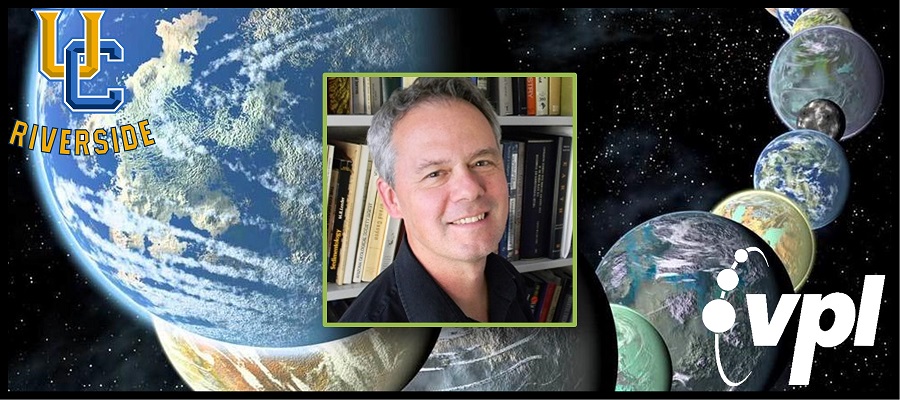VPL researchers Eddie Schwieterman and Heather Graham have been featured in an Aeon article on combating the uncertainty associated with…
VPL Postdoctoral Researcher, Andrew Lincowski (University of Washington), and VPL project PI, Victoria Meadows (University of Washington), published two new…
The observation of a 266.94 GHz feature in the Venus spectrum has been attributed to phosphine (PH3) in the Venus clouds, suggesting unexpected geological, chemical, or even biological processes. Since both PH3 and sulfur dioxide (SO2) are spectrally active near 266.94 GHz, the contribution to this line from SO2 must be determined before it can be attributed, in whole or part, to PH3. An undetected SO2 reference line, interpreted as an unexpectedly low SO2 abundance, suggested that the 266.94 GHz feature could be attributed primarily to PH3. However, the low SO2 and the inference that PH3 was in the cloud deck posed an apparent contradiction. Here we use a radiative transfer model to analyze the PH3 discovery, and explore the detectability of different vertical distributions of PH3 and SO2. We find that the 266.94 GHz line does not originate in the clouds, but above 80 km in the Venus mesosphere. This level of line formation is inconsistent with chemical modeling that assumes generation of PH3 in the Venus clouds. Given the extremely short chemical lifetime of PH3 in the Venus mesosphere, an implausibly high source flux would be needed to maintain the observed value of 20 ± 10 ppb. We find that typical Venus SO2 vertical distributions and abundances fit the JCMT 266.94 GHz feature, and the resulting SO2 reference line at 267.54 GHz would have remained undetectable in the ALMA data due to line dilution. We conclude that nominal mesospheric SO2 is a more plausible explanation for the JCMT and ALMA data than PH3.
The UCR-based Alternative Earth’s Team has received a five-year funding award from the Interdisciplinary Consortium for Astrobiology Research (ICAR). VPL…
We present a study of the photochemistry of abiotic habitable planets with anoxic CO2–N2 atmospheres. Such worlds are representative of early Earth, Mars, and Venus and analogous exoplanets. Photodissociation of H2O controls the atmospheric photochemistry of these worlds through production of reactive OH, which dominates the removal of atmospheric trace gases.
The habitable zone (HZ) is commonly defined as the range of distances from a host star within which liquid water, a key requirement for life, may exist on a planet’s surface. Substantially more CO2 than present in Earth’s modern atmosphere is required to maintain clement temperatures for most of the HZ, with several bars required at the outer edge. However, most complex aerobic life on Earth is limited by CO2 concentrations of just fractions of a bar. At the same time, most exoplanets in the traditional HZ reside in proximity to M dwarfs, which are more numerous than Sun-like G dwarfs but are predicted to promote greater abundances of gases that can be toxic in the atmospheres of orbiting planets, such as carbon monoxide (CO). Here we show that the HZ for complex aerobic life is likely limited relative to that for microbial life. We use a 1D radiative-convective climate and photochemical models to circumscribe a Habitable Zone for Complex Life (HZCL) based on known toxicity limits for a range of organisms as a proof of concept. We find that for CO2 tolerances of 0.01, 0.1, and 1 bar, the HZCL is only 21%, 32%, and 50% as wide as the conventional HZ for a Sun-like star, and that CO concentrations may limit some complex life throughout the entire HZ of the coolest M dwarfs. These results cast new light on the likely distribution of complex life in the universe and have important ramifications for the search for exoplanet biosignatures and technosignatures.
Some atmospheric gases have been proposed as counter indicators to the presence of life on an exoplanet if remotely detectable at sufficient abundance (i.e., antibiosignatures), informing the search for biosignatures and potentially fingerprinting uninhabited habitats. However, the quantitative extent to which putative antibiosignatures could exist in the atmospheres of inhabited planets is not well understood. The most commonly referenced potential antibiosignature is CO, because it represents a source of free energy and reduced carbon that is readily exploited by life on Earth and is thus often assumed to accumulate only in the absence of life. Yet, biospheres actively produce CO through biomass burning, photooxidation processes, and release of gases that are photochemically converted into CO in the atmosphere. We demonstrate with a 1D ecosphere-atmosphere model that reducing biospheres can maintain CO levels of ~100 ppmv even at low H2 fluxes due to the impact of hybrid photosynthetic ecosystems. Additionally, we show that photochemistry around M dwarf stars is particularly favorable for the buildup of CO, with plausible concentrations for inhabited, oxygen-rich planets extending from hundreds of ppm to several percent. Since CH4 buildup is also favored on these worlds, and because O2 and O3 are likely not detectable with the James Webb Space Telescope, the presence of high CO (>100 ppmv) may discriminate between oxygen-rich and reducing biospheres with near-future transmission observations. These results suggest that spectroscopic detection of CO can be compatible with the presence of life and that a comprehensive contextual assessment is required to validate the significance of potential antibiosignatures.
Earthshine is the dominant source of natural illumination on the surface of the Moon during lunar night, and at some locations within permanently shadowed regions (PSRs) near the poles that never receive direct sunlight. As such, earthshine has the potential to enable the scientific investigation and exploration of conditions in areas of the Moon that are either temporarily or permanently hidden from the Sun. Earthshine has also been used to refer to Earthlight reflected from the lunar surface, but in this study we use it to refer specifically to Earthlight incident at the Moon. Under certain circumstances, the heat flux from earthshine could also influence the transport and cold-trapping of volatiles present in the very coldest areas within PSRs. In this study, Earth’s spectral irradiance, as it would appear at the Moon in the solar reflectance band (0.3–3.0 µm) and at thermal emission wavelengths (3–50 µm), is examined with a suite of model image cubes and whole-disk spectra created using the Virtual Planetary Laboratory (VPL) three-dimensional (latitude, longitude and altitude) modeling capability
Proxima Centauri b provides an unprecedented opportunity to understand the evolution and nature of terrestrial planets orbiting M dwarfs. Although Proxima Cen b orbits within its star’s habitable zone, multiple plausible evolutionary paths could have generated different environments that may or may not be habitable. Here, we use 1-D coupled climate-photochemical models to generate self-consistent atmospheres for several evolutionary scenarios, including high-O2, high-CO2, and more Earth-like atmospheres, with both oxic and anoxic compositions. We show that these modeled environments can be habitable or uninhabitable at Proxima Cen b’s position in the habitable zone. We use radiative transfer models to generate synthetic spectra and thermal phase curves for these simulated environments, and use instrument models to explore our ability to discriminate between possible planetary states.
O2 and O3 have been long considered the most robust individual biosignature gases in a planetary atmosphere, yet multiple mechanisms that may produce them in the absence of life have been described. However, these abiotic planetary mechanisms modify the environment in potentially identifiable ways. Here we briefly discuss two of the most detectable spectral discriminants for abiotic O2/O3: CO and O4. We produce the first explicit self-consistent simulations of these spectral discriminants as they may be seen by James Webb Space Telescope (JWST). If JWST-NIRISS and/or NIRSpec observe CO (2.35, 4.6 μm) in conjunction with CO2 (1.6, 2.0, 4.3 μm) in the transmission spectrum of a terrestrial planet it could indicate robust CO2 photolysis and suggest that a future detection of O2 or O3 might not be biogenic. Strong O4 bands seen in transmission at 1.06 and 1.27 μm could be diagnostic of a post-runaway O2-dominated atmosphere from massive H-escape. We find that for these false positive scenarios, CO at 2.35 μm, CO2 at 2.0 and 4.3 μm, and O4 at 1.27 μm are all stronger features in transmission than O2/O3 and could be detected with S/Ns gsim 3 for an Earth-size planet orbiting a nearby M dwarf star with as few as 10 transits, assuming photon-limited noise. O4 bands could also be sought in UV/VIS/NIR reflected light (at 0.345, 0.36, 0.38, 0.445, 0.475, 0.53, 0.57, 0.63, 1.06, and 1.27 μm) by a next generation direct-imaging telescope such as LUVOIR/HDST or HabEx and would indicate an oxygen atmosphere too massive to be biologically produced.
In the search for life on Earth-like planets around other stars, the first (and likely only) information will come from the spectroscopic characterization of the planet’s atmosphere. Of the countless number of chemical species terrestrial life produces, only a few have the distinct spectral features and the necessary atmospheric abundance to be detectable. The easiest of these species to observe in Earth’s atmosphere is O2 (and its photochemical byproduct, O3).
Characterizing the bulk atmosphere of a terrestrial planet is important for determining surface pressure and potential habitability. Molecular nitrogen (N2) constitutes the largest fraction of Earth’s atmosphere and is likely to be a major constituent of many terrestrial exoplanet atmospheres. Due to its lack of significant absorption features, N2 is extremely difficult to remotely detect. However, N2 produces an N2–N2 collisional pair, (N2)2, which is spectrally active. Here we report the detection of (N2)2 in Earth’s disk-integrated spectrum.
(Astrobiology, 2015)
The Lunar CRater Observation and Sensing Satellite (LCROSS) observed the distant Earth on three occasions in 2009. These data span a range of phase angles, including a rare crescent phase view. For each epoch, the satellite acquired near-infrared and mid-infrared full-disk images, and partial-disk spectra at 0.26-0.65 μm (λ/Δλ ~ 500) and 1.17-2.48 μm (λ/Δλ ~ 50). Spectra show strong absorption features due to water vapor and ozone, which is a biosignature gas. We perform a significant recalibration of the UV-visible spectra and provide the first comparison of high-resolution visible Earth spectra to the NASA Astrobiology Institute’s Virtual Planetary Laboratory three-dimensional spectral Earth model. We find good agreement with the observations, reproducing the absolute brightness and dynamic range at all wavelengths for all observation epochs, thus validating the model to within the ~10% data calibration uncertainty.


